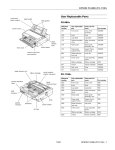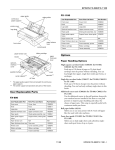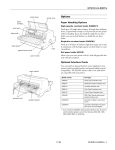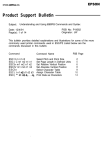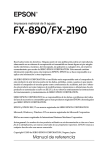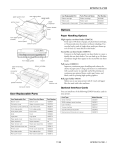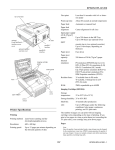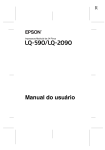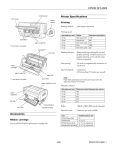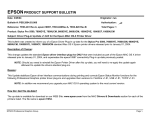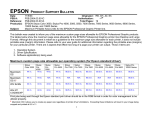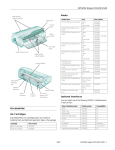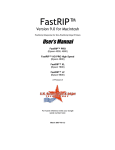Download Epson FX-890N Product information guide
Transcript
PRODUCT INFORMATION GUIDE EPSON UPDATE 6/11/03 This package provides a new dot matrix printer product section to be added to the EPSON Product Information Guide. The table of contents of this section is listed below. EPSON FX-890/FX-2190 TABLE OF CONTENTS User Replaceable Parts...................................................................................... EPSON FX-890/FX-2190 - 1 Options ............................................................................................................ EPSON FX-890/FX-2190 - 1 Printer Specifications........................................................................................ EPSON FX-890/FX-2190 - 2 Control Panel Buttons and Lights .................................................................... EPSON FX-890/FX-2190 - 7 Error Indicators ................................................................................................ EPSON FX-890/FX-2190 - 8 Selecting a Font and Pitch ................................................................................ EPSON FX-890/FX-2190 - 8 Selecting a Paper Source ................................................................................... EPSON FX-890/FX-2190 - 9 Setting the Paper Release Lever......................................................................... EPSON FX-890/FX-2190 - 10 Adjusting the Paper-Thickness Setting ............................................................. EPSON FX-890/FX-2190 - 10 Using the Micro Adjust Function ..................................................................... EPSON FX-890/FX-2190 - 11 Loading Special Papers ..................................................................................... EPSON FX-890/FX-2190 - 12 Switching Paper Types ..................................................................................... EPSON FX-890/FX-2190 - 13 Clearing Paper Jams ......................................................................................... EPSON FX-890/FX-2190 - 14 Changing the Default Settings.......................................................................... EPSON FX-890/FX-2190 - 14 Emulating the Okidata Microline 320/321 Turbo............................................ EPSON FX-890/FX-2190 - 15 Locking the Control Panel Buttons .................................................................. EPSON FX-890/FX-2190 - 16 Aligning Vertical Lines in Your Printout .......................................................... EPSON FX-890/FX-2190 - 16 Printing a Self Test ........................................................................................... EPSON FX-890/FX-2190 - 17 Printing a Hex Dump....................................................................................... EPSON FX-890/FX-2190 - 17 Resetting the Printer......................................................................................... EPSON FX-890/FX-2190 - 17 Cleaning the Printer ......................................................................................... EPSON FX-890/FX-2190 - 18 Transporting the Printer................................................................................... EPSON FX-890/FX-2190 - 18 Related Documentation.................................................................................... EPSON FX-890/FX-2190 - 18 6/03 EPSON FX-890/FX-2190 Paper guide User Replaceable Parts Edge guides Paper guide cover The table below lists the user replaceable parts for the FX-890. The parts for the FX-2190 will be added when they are available. Printer cover FX-890 Paper release lever Front cover Control panel Power switch Ribbon cartridge Reference number User replaceable part Parts price list name 107 Front cover Cover assembly, front 1261493 108 Knob Knob 1234171 120 Logo plate Logo plate 1242638 115 Optional interface cover Upper connector cover 1236524 106 Paper guide Sheet guide assembly, rear 1254860 121 Paper thickness lever cap Lever cap 1242257 104 Printer cover Cover assembly, printer 1261494 Ribbon cartridge Ribbon cartridge S015329 541 Tractor Tractor assembly 1254859 105 Rear wing Wing 1235796 101 Rubber foot Foot 1004605 Paper thickness lever Paper tension unit Part number Options AC inlet Paper Handling Options High-capacity cut-sheet feeder (C806381 for FX-890, C806401 for FX-2190) Sprockets Knob Feeds up to 150 sheets of paper or 25 plain bond envelopes into the printer without reloading. You can load single sheets, single-sheet multi-part forms, or envelopes. Optional interface cover USB interface Parallel interface Single-bin cut-sheet feeder (C806371 for FX-890, C806391 for FX-2190) Feeds up to 50 sheets of paper into the printer without reloading. Load only ordinary single sheets in this feeder. Pull tractor unit (C800201 for FX-890, C800211 for FX-2190) Use the additional tractor in the pull position along with your standard tractor installed in the front or rear push position to improve paper handling and reduce the chance of paper jams. This setup is especially useful with continuous multi-part forms. 6/03 EPSON FX-890/FX-2190 - 1 EPSON FX-890/FX-2190 Roll paper holder (8310) Printer Specifications Allows you to use your printer with 8.5-inch roll paper. Front sheet guide (C814001 for FX-890, C814011 for FX-2190) Mechanical Allows you to load single sheets and carbonless single-sheet multi-part forms of up to 6 parts. Printing method 9-pin impact dot matrix Printing speed Ultra speed draft 566 cps at 10 cpi 680 cps at 12 cpi Front paper guide (C814021 for FX-890, C814031 for FX-2190) High-speed draft 559 cps at 10 cpi 627 cps at 12 cpi Allows you to load single sheets and carbonless single-sheet multi-part forms of up to 6 parts without removing the tractor from the front push position. Draft 419 cps at 10 cpi 503 cps at 12 cpi Optional Interface Cards You can install an optional interface card to supplement your printer’s built-in USB and parallel interfaces and provide added network compatibility. The EPSON interface cards in the table below are compatible with your printer. Card type Model number Serial interface C823051 32 KB intelligent serial interface C823071 Coax interface C823141 Twinax interface C823151 IEEE-1284 parallel interface C823452 EpsonNet 10/100 Base TX Internal Print Server C12C823912 Near letter quality 104 cps at 10 cpi 125 cps at 12 cpi Note: Other network interface cards (such as the C823622A, C823632A, and C823642A) are also supported on this printer. Check with EPSON for more information. Printing direction Bidirectional logic seeking for text and graphics printing. Unidirectional text or graphics printing can be selected using software commands. Line spacing 1/6-inch or programmable in 1/432-inch increments Printable columns FX-890: 80 columns (at 10 cpi) FX-2190: 136 columns (at 10 cpi) Resolution 240 × 144 dpi (near letter quality) Paper feed methods Friction (front, rear) Push tractor (front, rear) Pull tractor (front, bottom, rear) Push and pull tractor (front, rear); additional tractor is required Cut-sheet feeders (optional) Roll paper holder (optional) Paper feed speed Normal mode: 1/6-inch (4.23 mm) feed, 62 msec; Continuous: 5 inches (127 mm)/ second Copy mode: 1/6-inch (4.23 mm) feed, 83 msec; Continuous: 3.1 inches (78 mm)/ second; 2 - EPSON FX-890/FX-2190 6/03 EPSON FX-890/FX-2190 Paper capacity Electronic Single-bin cut-sheet feeder up to 50 sheets of 22 lb (82 g/m²) paper Interfaces One standard bidirectional 8-bit parallel interface with IEEE 1284 nibble mode support, one USB (ver 1.1) interface, and one optional Type B interface slot Buffer 128KB Built-in fonts Bitmap fonts: EPSON Draft 10, 12, 15, 17, 20 cpi EPSON Roman 10, 12, 15 , 17, 20 cpi, proportional EPSON Sans Serif 10, 12, 15, 17, 20 cpi, proportional Note: The total thickness of the paper stack can be up to 0.20 inch (5 mm). High-capacity cut-sheet feeder up to 150 sheets of 22 lb (82 g/m²) paper up to 25 plain or bond envelopes up to 30 airmail envelopes Note: The total thickness of the paper stack can be up to 0.59 inch (15 mm). Reliability Total print volume 52 million lines (except print head) Bar code fonts: EAN-13, EAN-8, Interleaved 2 of 5, UPC-A, UPC-E, Code 39, Code 128, POSTNET, Coda bar (NW-7), Industrial 2 of 5, Matrix 2 of 5 MTBF 20,000 POH (25% duty) Print head life 400 million strokes per wire; approximately 400 million characters (Draft, 10 cpi, 14 dots/character) Character tables Acoustic noise Approx. 55 dB (A) (ISO 7779 pattern) Character sets Dimensions and weight Height 6.6 inches (167.5 mm) NLSP version: 42 character tables 13 international character sets Electrical Width FX-890: 16.3 inches (414 mm) FX-2190: 23.2 inches (589 mm) Depth 13.8 inches (350 mm) Weight FX-890: 16.8 lb (7.6 kg) FX-2190: 21.7 lb (9.6 kg) Ribbon Standard version: 13 character tables Black ribbon cartridge FX-890: S015329 FX-2190: S015327 Ribbon life * FX-890: approx. 7.5 million characters FX-2190: approx. 12 million characters 120 V 220 to 240 V Universal (UPS) Rated voltage range 120 V 220 to 240 V 100 to 240 V Input voltage range 103.5 to 132 V 198 to 264 V 90 to 264 V Rated frequency range 50 to 60 Hz Input frequency range 49.5 to 60.5 Hz Rated current 1.1 A (maximum 2.5 A depending on the character type) Power consumption Approx. 40W (ISO/IEC 10561 letter pattern) * (Draft, 10 cpi, 14 dots/character) System Compatibility The printer supports the following versions of Microsoft Windows: 0.6 A (maximum 1.3 A depending on the character type) 1.1 A/ 0.5 A, 3.0 A/1.2A maximum depending on the character type Approx. 56W (ISO/IEC 10561 letter pattern) ❏ Windows 95 and NT 4.0: parallel interface only. ❏ Windows 98*, Me, 2000, XP: parallel and USB interfaces. * If you are using the USB interface, the printer requires the Se version of Windows 98. 6/03 EPSON FX-890/FX-2190 - 3 EPSON FX-890/FX-2190 Environmental Single-sheet multipart forms (for the optional front sheet or front paper guide only): Humidity (without condensation) Minimum Maximum Width (inch) (mm) 3.9 100 FX-890: 10.1 257 FX-2190: 16.5 420 Length ((inch) (mm) 3.9 100 14.3 364 16.5 420 Copies 1 original + 5 copies Paper Total thickness (inch) (mm) 0.0047 0.12 0.018 0.46 Use recycled paper, multipart paper, labels, envelopes, and roll paper only under normal temperature and humidity conditions, as follows: Weight per sheet of multipart (lb) (g/m²) 12 40 15 58 Temperature Operation (plain paper) 41 to 95 °F (5 to 35 °C) 10 to 80% RH Operation 59 to 77 °F (15 to 25 °C) (recycled paper, envelopes, labels or roll paper) 30 to 60% RH Storage 0 to 85% RH –22 to 140 °F (–30 to 60 °C) Quality Temperature Humidity 59 to 77 °F (15 to 25 °C) 30 to 60% RH Continuous paper (ordinary and multipart): Do not load paper that has been folded or is damaged, wrinkled, or curled. Single sheets, front or rear entry Minimum Maximum Width* (inch) (mm) 3.9 100 FX-890: 10.1 257 Length** (inch) (mm) 3.9 100 14.3 364 Thickness*** (inch) (mm) 0.0025 0.065 0.0055 0.14 Weight (lb) (g/m²) 14 52 24 90 Quality Plain paper and recycled paper Carbonless multipart forms with a line of glue at the top or one side of the form FX-2190: 16.5 420 * 7.2 to 8.5 inches (182 to 216 mm) using the optional cut-sheet feeder for FX-890. 7.2 to 16.5 inches (182 to 420 mm) using the optional cut-sheet feeder for FX-2190. Minimum Maximum Width (inch) (mm) 4.0 101.6 FX-890: 10.0 254.0 Length, one page (inch) (mm) 4.0 101.6 22.0 558.8 Copies 1 original + 5 copies Total thickness (inch) (mm) 0.0025 0.065 0.018 0.46 Weight, ordinary paper (lb) (g/m²) 14 52 22 82 Weight per sheet of multipart (lb) (g/m²) 12 40 15 58 Quality FX-2190: 16.0 406.4 Plain paper, recycled paper, and carbonless multipart forms with point gluing or paper stapling on both sides ** 8.3 to 14.3 inches (210 to 364 mm) using the optional cut-sheet feeder. Do not load thick paper, such as multipart forms with five or six parts, in the rear slot. ***0.0028 to 0.0055 inch (0.07 to 0.14 mm) using the optional cut-sheet feeder. The ratio of the cut/uncut length at the perforation should be between 3:1 and 5:1. The thickness of the perforation part when extended should be 1 mm or less. The perforation between pages should not extend all the way to the edges of the paper. Uncut length on the edges should be 1 mm or more. The horizontal and vertical perforation cuts should not cross. 4 - EPSON FX-890/FX-2190 6/03 EPSON FX-890/FX-2190 Continuous labels (front and bottom entry only): Envelopes (rear entry only): Use only labels mounted on continuous backing sheets. Minimum Minimum Envelope size (No. 6) Maximum Label size See the figure below. Width, backing sheet (inch) (mm) 4.0 101.6 FX-890: 10.0 254.0 Length, backing sheet (inch) (mm) 4.0 101.6 22.0 558.8 Thickness, backing sheet (inch) (mm) 0.0028 0.07 0.0035 0.09 Total thickness (inch) (mm) 0.0063 0.16 0.0075 0.19 Label weight (lb) (g/m²) 17 64 Quality Plain paper FX-2190: 16.0 406.4 Envelope size (No. 10) Total thickness (inch) (mm) Width (inch) (mm) 6.5 165 Length (inch) (mm) 3.6 92 Width (inch) (mm) 9.5 241 Length (inch) (mm) 4.1 105 Maximum 0.0063 0.16 0.0205 0.52 Differences in thickness within the printable area must be less than 0.0098 inch (0.25 mm) Weight (lb) (g/m²) Quality 12 45 24 90 Bond envelopes, plain envelopes, and airmail envelopes without glue on the flap Roll paper (rear entry with optional roll paper holder only): Minimum A 2.5 inches (63.5 mm) minimum Width (inch) (mm) B 15/16 inch (23.8 mm) minimum C Corner radius = 0.1 inch (2.5 mm) minimum Length (inch) (mm) 6/03 Maximum 8.5 216 —— Thickness (inch) (mm) 0.0028 0.07 0.0035 0.09 Weight (lb) (g/m²) 14 52 22 82 Quality Plain paper EPSON FX-890/FX-2190 - 5 EPSON FX-890/FX-2190 Printable Area Envelopes Single sheets A The minimum top and bottom margins are 0.17 inch (4.2 mm). B The minimum left and right margins are 0.12 inch (3 mm). Roll paper A The minimum top and bottom margins are 0.17 inch (4.2 mm). A The minimum top and bottom margins are 0.2 inch (4.2 mm). B The minimum left and right margins are 0.12 inch (3 mm). The maximum printable width is 8.0 inches (203.2 mm). B FX-890: The minimum left and right margins are 0.1 inch (3 mm). The maximum printable width is 8.0 inches (203.2 mm). FX-2190: The minimum left and right margins are 0.1 inch (3 mm). The maximum printable width is 13.6 inches (345.4 mm). For paper wider than 8.2 inches (209.2 mm), the side margins increase to match the width of the paper. Standards and Approvals Continuous paper 120 V (US model) Safety standards UL 1950 CSA C22.2 No. 950 EMI FCC part 15 subpart B class B CSA C108.8 class B 230 V (European model) Safety standard EN 60950 A The minimum top and bottom margins above and below the perforation are 0.17 inch (4.2 mm). EMI B FX-890: The minimum left and right margins are 0.51 inch (13 mm). The maximum printable width is 8.0 inches (203.2 mm). For paper wider than 9.0 inches (229.2 mm), the side margins increase to match the width of the paper. Universal (UPS) model Safety standards UL 1950 CSA C22.2 No. 950 EN 60950 FX-2190: The minimum left and right margins are 0.51 inch (13 mm). The maximum printable width is 13.9 inches (351.8 mm). For paper wider than 14.9 inches (377.8 mm), the side margins increase to match the width of the paper. 6 - EPSON FX-890/FX-2190 EN 55022 (CISPR pub. 22) class B AS/NZS 3548 class B EMI 6/03 FCC part 15 subpart B class B CSA C108.8 class B EN 55022 (CISPR pub. 22) class B AS/NZS 3548 class B EPSON FX-890/FX-2190 9 Control Panel Buttons and Lights LF/FF button Feeds paper line by line when pressed quickly. Ejects a single sheet or advances continuous paper to the next top-of-form position when held down. 10 Pause light On when the printer is paused. Flashes when the printer is in Micro Adjust mode. 11 Pause button Stops printing temporarily, and resumes printing when pressed again. When held down for three seconds, enters the Micro Adjust mode. When pressed again, exits the Micro Adjust mode. Button/Light Function 1 Font button Selects one of the fonts. See “Selecting a Font and Pitch” on page 8. Font lights Indicate which font is selected. 2 Reset When you press both the Font and Pitch buttons simultaneously, the printer clears the buffer and restores its default settings. 3 Pitch button Selects one of the pitch settings. See “Selecting a Font and Pitch” on page 8. Pitch lights Indicate which pitch is selected. Tear Off/Bin button Feeds continuous paper forward to the tear-off position. 4 12 Lock function The table below summarizes the power-on functions available through the control panel. To perform the function on the right, hold down the button(s) on the left while you turn on the printer. Both flash when continuous paper is in the tear-off position. Both off when continuous paper is not in the tear-off position or when bin 1 of the optional cut-sheet feeder is selected. Left light is on when Card mode is selected. Right light is on when bin 2 of the optional cut-sheet feeder is selected. 6 7 Menu Set When Lock-out mode is on, the Paper Out and Pause lights flash if a locked button is pressed. See the Reference Guide for more information. Power-on Functions Selects a cut-sheet feeder bin when the cut-sheet feeder is installed. 5 On when no paper is loaded in the selected paper source or paper is not loaded correctly. Flashes when paper has not been fully ejected or paper is jammed. Feeds continuous paper backward from the tear-off position to the top-of-form position. Tear Off/Bin lights Paper Out light When you press the Pitch and Tear Off/Bin buttons at the same time, the printer enters the default setting mode. See “Changing the Default Settings” on page 14. In default setting mode, you can press the Tear Off/Bin button to select a value. Load/Eject button Loads a single sheet of paper. Ejects a single sheet of paper. Loads continuous paper from the standby position. Control panel button Function Load/Eject NLQ self test LF/FF Draft self test Load/Eject + LF/FF Data (Hex) dump Load/Eject + LF/FF + Pause EEPROM reset Pause Bidirectional adjustment mode Load/Eject + Pause Control panel Lock-out mode (on/off) LF/FF + Pause Default settings for control panel Lock-out mode Font + Pitch Quiet mode Pitch + Pause Copy mode Font + Tear Off/Bin Default setting, simple mode Tear Off/Bin + Pause Okidata ML 320T/321T mode Tear Off/Bin + Load/Eject Reset the Driving Line count for ribbon change timing Font + Pitch + Tear Off/Bin Program reload mode Feeds continuous paper backward to the standby position if a sheet is loaded. 8 Micro Adjust When you hold down the Pause button for three seconds, the printer enters the Micro Adjust mode. In this mode, you can press the LF/FF D and Load/Eject U buttons to adjust the top-of-form or tear-off position. See “Using the Micro Adjust Function” on page 11. 6/03 EPSON FX-890/FX-2190 - 7 EPSON FX-890/FX-2190 Error Indicators Selecting a Font and Pitch If the printer stops working and one or more control panel lights are on or flashing, or the printer beeps, use the following table to diagnose and fix the problem. Usually, you use your application program to select the font and pitch you want to use in a document. However, you can select one of the printer’s five fonts (in different pitches) with the buttons on the printer’s control panel, as described below. Light status Beep pattern Note: Settings you make in application programs usually override settings you make from the printer’s control panel. For best results, use your application to select a font and make other settings. Problem Solution O Paper Out O Pause ••• No paper is loaded in the selected paper source. The available pitch depends on the font you select. See the table below for more information. Load paper in the printer or select a different paper source; the Paper Out light goes off. Then press the Pause button; the Pause light goes off and the printer starts printing. ••• O Pause ••• Font Pitch USD 10, 12 The paper is not loaded correctly. HSD 10, 12, 15, 17, 20 Remove your paper and reload it correctly. See the Reference Guide. Draft 10, 12, 15, 17, 20 Roman 10, 12, 15, 17, 20, PS The paper release lever is set to the wrong position. Sans Serif 10, 12, 15, 17, 20, PS Set the paper release lever to the position for the paper source you want to use. If paper from another paper source is currently in the paper path, press the Load/Eject button to eject the paper; then move the paper release lever to the desired position. O Paper Out O Pause ••• ••• 1. Make sure that the printer is not printing. If it is, press the Pause button to stop printing. 2. Press the Font button until the three Font lights indicate the desired font as shown below. A single sheet of paper is not fully ejected. N N O USD N O N HSD Press the Load/Eject button to eject the sheet. N O O Draft O N N Roman O N O Sans Serif Continuous paper is not fed to the standby position. Tear off the printed page at the perforation; then press Load/Eject to feed the paper to the standby position. ••• O=On, N=Off 3. Press the Pitch button until the three Pitch lights indicate the desired pitch as shown below. Paper is jammed in the printer. To clear the paper jam, see page 14. O Pause — The print head is overheated. Wait a few minutes; the printer resumes printing automatically once the print head cools. O Paper Out O Pause O O Tear Off/Bin O O O Font light O O O Pitch light ••••• An unknown or fatal printer error has occurred. Turn off the printer and leave it off for several minutes; then turn on the printer again. N N O 10 cpi N O N 12 cpi N O O 15 cpi O N N 17 cpi O N O 20 cpi O O O PS O=On, N=Off O = on, O = flashing ••• = three beeps, ••••• = five beeps 8 - EPSON FX-890/FX-2190 6/03 EPSON FX-890/FX-2190 Pull Tractor Position Selecting a Paper Source The pull tractor allows you to load continuous paper from the front, rear or bottom of the printer. However, you cannot use the tear-off feature when the tractor is in the pull position. Paper can be fed into the printer from the top, front, bottom, or rear. Select the paper source that best suits your current printing needs. To use the tractor in the pull position, you can remove the tractor from the rear push position and reinstall it in the pull position, or you can purchase the optional pull tractor unit (C800201 for the FX-890 or C800211 for the FX-2190) and install it in the pull position. Push Tractor Positions There are two push tractor positions: front and rear. The tractor is installed in the rear push position when the printer is shipped. Tractor position You can use the front, bottom, or rear paper slot with the pull tractor. Description Load paper from the front slot. Paper slot front push Description If you print on thick paper such as multipart forms, use the front paper slot because this paper path is almost straight. This reduces the chances of paper jams. If you print on thick paper such as multipart forms or continuous paper with labels, use the front paper slot because this paper path is nearly straight. This reduces the chances of paper jams. Load paper from the rear slot. front rear push Do not load continuous paper with labels from the rear slot. Labels require a straight paper path; otherwise they may come off their backing sheets inside the printer and cause a paper jam. The bottom paper slot has the straightest paper path, so it is the best slot to use when printing on thick paper, such as multipart forms or continuous paper with labels. The rear slot is also not recommended when your multipart forms have 5 or 6 parts (1 original plus 4 or 5 copies), because paper might jam. bottom rear When loading paper from the bottom slot, be sure to use a printer stand with an opening large enough for the paper to feed through it without obstruction. If the front or bottom paper slot is unavailable, you can also load ordinary continuous paper from the rear slot. Please note that loading paper from the rear slot results in a curved paper path, which may affect loading performance, so use the front or bottom slot whenever possible. Caution: Do not load continuous paper with labels from the rear slot. The labels may come off the backing sheets inside the printer and cause a paper jam. 6/03 EPSON FX-890/FX-2190 - 9 EPSON FX-890/FX-2190 Setting the Paper Release Lever Adjusting the Paper-Thickness Setting Set the paper release lever to indicate the paper source you want to use, as described in the table below. First turn off the printer and open the printer cover. Then set the paper-thickness setting for the type of paper you are using. (See the table below.) Lever position Description Single-sheet position For loading single-sheet paper from the top or front slot. Front push tractor position For loading continuous paper with the tractor installed in the front push position or when using the front push and pull tractors in combination. Rear push tractor position For loading continuous paper with the tractor installed in the rear push position or when using the rear push and pull tractors in combination. Pull tractor position For loading continuous paper from the tractor installed on top of the printer in the pull position. You can load paper in the front, rear, or bottom slot. 10 - EPSON FX-890/FX-2190 Paper type Lever position Ordinary paper 0 or 1 (single sheets) 0 (continuous paper) Thin paper 0 Carbonless multipart forms with: 2 parts (original + 1 copy) 3 parts (original + 2 copies) 4 parts (original + 3 copies) 5 parts (original + 4 copies) 6 parts (original + 5 copies) 7 parts (original + 6 copies) * 1 3 5 6 7 7 Continuous paper with labels 2 Postcards 2 Envelopes 5 or 6 * Available when using the tractor in the bottom or front pull position. Note: When the temperature is 41°F (5°C) or lower, or 95°F (35°C) or higher, set the paper-thickness lever one position lower to improve print quality. Multipart forms with 7 parts cannot be used at these temperatures. 6/03 EPSON FX-890/FX-2190 4. Tear off the printed pages. Using the Micro Adjust Function 5. Press the Pause button to turn off Micro Adjust mode. When you resume printing, the printer automatically feeds the paper back to the top-of-form position and begins printing. The Micro Adjust function allows you to move the paper forward or backward in 1/216-inch (0.118 mm) increments to adjust the tear-off and top-of-form positions. Adjusting the Top-of-form Position Adjusting the Tear-off Position The top-of-form position is the position on the page where the printer starts printing. If your printing appears too high or low on the page, you can use the Micro Adjust function to adjust the top-of-form position, as described below. Your top-of-form position setting remains in effect until you change it, even if you turn off the printer. If your paper’s perforation is not aligned with the tear-off edge, you can use the Micro Adjust function to move the perforation to the tear-off position. Your tear-off position setting remains in effect until you change it, even if you turn off the printer. Caution: Never use the knob to adjust the tear-off position; this may damage the printer or cause it to lose the tear-off position. Caution: Never use the knob to adjust the top-of-form position; this may damage the printer or cause it to lose the top-of-form position. 1. Make sure the Tear Off/Bin light is flashing (the paper is at the current tear-off position). You may need to press the Tear Off/Bin button to advance the paper to the tear-off position. 1. Make sure the printer is turned on. 2. Load paper. (If the tractor is in a push position, press the Load/Eject button to advance continuous paper to the current top-of-form position.) If necessary, lift up the printer cover so you can see the paper position. 3. Hold down the Pause button for three seconds. The Pause light flashes and the printer enters Micro Adjust mode. 4. Press the LF/FF D button to move the top-of-form position up on the page, or press the Load/Eject U button to move the top-of-form position down on the page. 2. Hold down the Pause button for about three seconds. The Pause light begins flashing and the printer enters Micro Adjust mode. 3. Open the paper guide cover and press LF/FF D to feed paper backward, or Load/Eject U to feed paper forward, until the paper perforation is aligned with the tear-off edge of the printer cover. tear-off edge 5. Press the Pause button to exit Micro Adjust mode. Note: The printer has a minimum and a maximum top-of-form position. If you try to adjust it beyond these limits, the printer beeps and stops moving the paper. When the paper reaches the default top-of-form position, the printer beeps and stops moving the paper briefly. You can use this setting as a reference point when adjusting the position. paper perforation The top margin setting made in some software overrides the top-of-form position setting you make with the Micro Adjust function. Note: The printer has a minimum and a maximum tear-off position. If you try to adjust the position beyond these limits, the printer beeps and stops moving the paper. 6/03 EPSON FX-890/FX-2190 - 11 EPSON FX-890/FX-2190 ❏ Do not load continuous paper with labels from the rear Loading Special Papers paper slot. Because the rear paper path is curved, labels may come off their backing sheets inside the printer and cause a paper jam. Follow the guidelines in this section when loading single-sheet multipart forms, labels, envelopes, and postcards. ❏ Do not load paper that is curled or has been folded. Single-sheet Multipart Forms To load single-sheet multipart forms, use the front paper entry slot with the optional front paper guide or front sheet guide installed. Thick paper, such as multipart forms with five or six parts, requires a straight paper path to avoid paper jams. Make sure the forms do not exceed 0.018 inch (0.46 mm). Removing Continuous Paper with Labels front paper guide To prevent labels from peeling off the backing sheet and jamming the printer, follow these steps to remove continuous paper with labels from the printer: 1. Tear off the fresh supply of continuous labels at the perforation nearest the paper entry slot. 2. Hold down the LF/FF button to eject the remaining labels from the printer. Caution: Never feed labels backward using the Load/Eject or Tear Off/Bin button. When fed backward, labels can easily come off the backing sheet and cause a paper jam. front sheet guide Envelopes Before loading envelopes, set the paper-thickness lever to position 5 (for thin envelopes) or 6 (for thick envelopes). You can feed envelopes one at a time using the paper guide, or you can load multiple envelopes using the optional high-capacity cut-sheet feeder (bin 1 of the double-bin cut-sheet feeder). Labels When printing on labels, use only the type of labels that are mounted on continuous backing sheets with sprocket holes for use with a tractor feeder. Do not try to print on single sheets with labels because the printer may not feed labels on a shiny backing sheet properly. Thick paper, such as continuous paper with labels, requires a straight or almost straight paper path. You can load labels in the front (to the pull tractor) or bottom (pull tractor) paper slot. The loading procedure for continuous paper with labels is the same as that for ordinary continuous paper, except you must set the paper-thickness lever to 2 before printing. Keep the following in mind: ❏ It is best to load continuous paper with labels on the pull tractor. Do not load labels on the rear or front push tractor. ❏ Never feed labels backward using the Load/Eject or Tear Off/Bin button. When fed backward, labels can easily Be sure to place the envelope printable side down and insert the top edge of the envelope into the printer first. peel off the backing sheet and cause a paper jam. The print head must not print past the left or right edge of the envelope or other thick paper. Make sure your application program prints entirely within the printable area of your envelope. ❏ Because labels are sensitive to temperature and humidity, use them only under normal operating conditions: Temperature: Humidity 59 to 77°F (15 to 25°C) 30 to 60% RH If you are using No. 6 envelopes, make sure the left edge guide is aligned with the arrow on the paper guide. ❏ Do not leave labels in the printer between jobs; they may curl around the platen and jam when you resume printing. 12 - EPSON FX-890/FX-2190 6/03 EPSON FX-890/FX-2190 Postcards 1. If any printed pages remain in the printer, press the Tear Off/Bin button to advance the paper to the tear-off position. Then tear off the printed pages. You can feed postcards one at a time using the paper guide, or you can load multiple cards using the optional high-capacity cut-sheet feeder (bin 1 of the double-bin cut-sheet feeder). The cards can be loaded only in the front or rear paper slot. Caution: Make sure you tear off your printed document before you press the Load/Eject button in the next step. Reverse feeding several pages at a time may cause a paper jam. Before loading postcards, set the paper-thickness lever to position 2 and set the paper release lever to the single-sheet position. 2. Press the Load/Eject button to feed the continuous paper backward to the standby position. The paper is still attached to the push tractor but is no longer in the paper path. When you are loading postcards long edge first, always load them in the top slot. 3. Move the paper guide to the upright position. 4. Set the paper release lever to the single-sheet position. 5. Load single sheets. Switching to Printing on Continuous Paper Follow the steps below to switch from printing on single sheets to printing on continuous paper with a push tractor. Note: To switch from printing with the optional front sheet guide to printing with the front push tractor, you need to remove the front sheet guide. 1. If a single sheet remains in the printer, press the Load/Eject button to eject it. Before printing, turn on the card mode by pressing the Tear Off/Bin button several times until the left Tear Off/Bin light is on. Caution: Never use the knob to eject paper when the printer is on; this may damage the printer or cause it to lose the top-of-form position. When loading A6 size cards, always load them long edge first. 2. Make sure the tractor is installed in the front or rear push position and that continuous paper is loaded on it. Switching Paper Types 3. Set the paper release lever to the front or rear push position, depending on the tractor position you are using. You can easily switch back and forth between printing on continuous paper with a push tractor and printing on single sheets without having to remove or reload the continuous paper. Your printer loads the continuous paper automatically when you begin printing. Switching to Printing on Single Sheets Follow the steps below to switch from printing on continuous paper from a push tractor to printing on single sheets. Note: If continuous labels are loaded in the printer, remove them before switching to single-sheet printing. If the tractor is in the pull position, remove any continuous paper from it before switching to single-sheet printing. 6/03 EPSON FX-890/FX-2190 - 13 EPSON FX-890/FX-2190 The following table shows the options available for each printer setting. Clearing Paper Jams Follow these steps to clear a paper jam: Setting Options (default in bold) 1. Turn off the printer and open the printer cover. Skip over perforation Off, On 2. If continuous paper is jammed in the printer, tear off the fresh supply at the perforation nearest the paper entry slot. Auto tear-off Off, On Auto line feed Off, On 3. Turn the knob on the left side of the printer away from you to remove the paper in the printer. Remove any remaining pieces of paper. Print direction Bi-D, Uni-D Software ESC/P, IBM PPDS I/F (interface) mode Auto, Parallel, USB, Option 4. If the paper is stuck where the printer ejects it, gently pull the paper out of the printer. Auto I/F (interface) wait time 10 seconds, 30 seconds Parallel I/F bidirectional mode Off, On Packet mode Off, Auto 0 slash 0, Buzzer Off, On Auto CR (available in IBM PPDS emulation mode) Off, On IBM character table* Table 2, Table1 Changing the Default Settings Page length for front tractor Length in inches: 3, 3.5, 4, 5.5, 6, 7, 8, 8.5, 11, 70/6, 12, 14, 17 While you can often change the printer’s settings through your software or printer driver, you may sometimes need to change one or more of the printer’s default settings. There are two ways to do this: Page length for rear tractor Length in inches: 3, 3.5, 4, 5.5, 6, 7, 8, 8.5, 11, 70/6, 12, 14, 17 Character table Standard model: italic, PC 437, PC 850, PC 860, PC 863, PC 865, PC 861, BRASCII, Abicomp, Roman 8, ISO Latin 1, PC858, ISO8859-15 All other models: Italic, PC 437, PC 850, PC 437 Greek, PC 853, PC855, PC 852, PC 857, PC 866, PC 869, MAZOWIA, Code MJK, ISO 8859-7, ISO Latin 1T, Bulgaria, PC 774, Estonia, ISO 8859-2, PC 866 LAT., PC 866 UKR, PC-APTEC, PC708, PC720, PC-AR864, PC 860, PC 865, PC 861, PC 863, BRASCSII, Abicomp, Roman 8, ISO Latin 1, PC858, ISO8859-15, PC771, PC437 Slovenia, PC MC, PC1250, PC1251 International character set for italic table (options depend on country) Italic U.S.A., Italic France, Italic Germany, Italic U.K., Italic Denmark 1, Italic Sweden, Italic Italy, Italic Spain 1 Manual feed wait time 1 second, 1.5 seconds, 2 seconds, 3 seconds Caution: Use the knob on the left side of the printer to clear paper jams only when the printer is off. Otherwise, you may damage the printer or change the top-of-form or tear-off position. 5. Close the printer cover and turn on the printer. Make sure the Paper Out light is not flashing and the Pause light is off. ❏ Using the EPSON Remote Configuration Manager on the printer software CD-ROM. (See the User’s Guide for more information.) ❏ From the printer’s control panel using the default-setting mode. For instructions on using the Remote Configuration Manager, see the PDF manual on the CD-ROM. To use the control panel, see below. For detailed information about default settings, see the Reference Guide. 14 - EPSON FX-890/FX-2190 6/03 (the zero character with a slash) EPSON FX-890/FX-2190 Follow the steps below to enter the default-setting mode. You’ll need four sheets of A4 or letter size single-sheet paper or four pages of continuous paper that is at least 11 inches (279 mm) long and 8.3 inches (210 mm) wide. If you use single sheets, you need to load a new sheet of paper each time the printer ejects a printed sheet from the paper guide. Emulating the Okidata Microline 320/ 321 Turbo You can make your FX-890 or FX-2190 work like the Okidata® Microline® 320 Turbo or 321 Turbo. In Okidata mode, the printer emulates Okidata functions, and the following additional settings can be selected in the default setting mode. The default settings (shown in bold) are consistent with Okidata Microline 320/321 Turbo factory settings. 1. Make sure the printer is on and paper is loaded. Then press the Pitch and Tear Off/Bin buttons to open the Menu. The Menu lights (both the Tear Off/Bin lights) turn on, and the printer enters the default-setting mode and prints the language selection instructions. 2. Press the Font button until the Font lights show the language you want, as described in the instructions. 3. Press the Tear Off/Bin button to print the default-setting mode instructions (three pages) in the language you selected. The printed instructions list the settings you can change, describe how to change them, and show how the control panel lights help you make settings. Use these instructions to change the printer’s default settings from the control panel. Feature Printer settings in Okidata mode Software emulation IBM PPDS, EPSON ESC/P, Oki ML 320T Auto tear off wait time 0.5 second, 1 second, 2 seconds, Others Bottom margin 4.2 mm, 20 mm, 22 mm, 24 mm, Others Line spacing (lines per inch) 6 LPI, 8 LPI Paper out override Off (No), On (Yes) Note: The FX-890 and FX-2190 do not support the USB interface in Okidata mode. If you want to use your printer in Okidata mode, do not install the Windows driver that came with your printer. If you have been using an Okidata driver, you can continue to use it with your printer in Okidata mode. 4. When you finish making settings, press the Menu buttons (Pitch and Tear Off/Bin) to exit the default-setting mode. If you have been using an Okidata printer, you may want to print out its default settings for reference before changing modes on the FX-890/FX-2190. To do this on the Okidata printer, press SHIFT + SEL to enter Menu mode, and then press PRINT. To enter Okidata mode on your FX-890/FX-2190, make sure the printer is turned off. Then hold down the Tear Off/Bin and Pause buttons while you turn on the printer. The printer beeps once to indicate it is now in Okidata mode. It remains in Okidata mode until you repeat the above procedure. To return to FX-890/FX-2190 mode, hold down the Tear Off/Bin and Pause buttons while you turn on the printer. The printer beeps twice and is now operating in FX-890/2190 mode. When you switch from one mode to the other, any changes you made to the printer’s settings in the original mode are restored to their default values. You can print the default settings for the printer to check the current settings and change them if necessary. See page 14. 6/03 EPSON FX-890/FX-2190 - 15 EPSON FX-890/FX-2190 3. Follow the instructions to change the settings as desired. Locking the Control Panel Buttons 4. Turn off the printer. When you want to turn on Lock-out mode, follow the steps above. You can restrict the use of buttons on the control panel using Lock-out mode. In the default Lock-out mode, you can use only the Pause, Load/Eject and Tear off buttons. If you want to change which functions are locked, see “Changing the Lock-out Mode Settings” below. Aligning Vertical Lines in Your Printout Turning Lock-out Mode On and Off If you notice that the vertical lines in your printout are not properly aligned, you can use the printer’s bidirectional adjustment mode to correct this problem. During bidirectional adjustment, the printer prints three sheets of alignment patterns, labeled High Speed Draft, Draft, and NLQ (near letter quality). You select the best alignment pattern from each sheet. 1. Make sure the printer is turned off. 2. Turn on the printer while holding down the Load/Eject and Pause buttons. The printer beeps twice, indicating that Lock-out mode has been turned on. When Lock-out mode is on, the Pause and Paper Out lights flash three times when any locked button is pressed. To turn Lock-out mode off, repeat steps 1 and 2. The printer beeps once, to indicate that Lock-out mode has been turned off. To print the instruction sheet and alignment patterns, you need four single sheets or four pages of continuous paper of at least the following sizes: Changing the Lock-out Mode Settings You can select which printer functions you want to be locked while Lock-out mode is on (as described below). The following table shows which functions you can lock and their default settings (in Lock-out mode). Paper type FX-890 FX-2190 Continuous paper (including perforated border) 9.5 × 11 inches (241 × 279 mm) 14.8 × 11 inches (376 × 279 mm) Single sheet A4 or letter size A3 landscape If you use single sheets, you need to load a new sheet of paper each time the printer ejects a printed sheet from the paper guide. Function Default setting Load Unlocked Eject Unlocked LF Locked Follow these steps to perform the bidirectional adjustment: FF Locked 1. Make sure paper is loaded, then turn off the printer. Tear Off Unlocked Bin Locked Micro Adjust Locked Font Locked 2. While holding down the Pause button, turn on the printer. The printer enters the bidirectional adjustment mode and then prints instructions and the first set of alignment patterns. Pitch Locked Pause Unlocked Reset Locked Menu Locked 3. As described in the instructions, compare the alignment patterns and select the pattern with the best alignment. Then select the pattern with the best alignment for each of the remaining sets of alignment patterns. 4. After you select the best pattern in the final set of alignment patterns, save your selection by pressing the Tear Off/Bin button. Then turn off the printer. 1. Make sure paper is loaded and the printer is turned off. 2. Turn on the printer while holding down the LF/FF and Pause buttons. The printer enters the Lock-out setting mode and prints the instructions. (You’ll need three sheets of A4 or letter size single-sheet paper or three pages of continuous paper that is at least 11 inches [279 mm] long and 8.3 inches [210 mm] wide.) 16 - EPSON FX-890/FX-2190 6/03 EPSON FX-890/FX-2190 Printing a Self Test Printing a Hex Dump Running the printer’s self test helps you determine whether the printer or the computer is causing the problem: The hex dump feature is designed for DOS-based PC connections. If you are an experienced user or a programmer, you can print a hexadecimal dump to isolate communication problems between the printer and your software program. In hex dump mode, the printer prints all data it receives from the computer as hexadecimal values. ❏ If the self test results are satisfactory, the printer is working properly and the problem probably results from your printer driver settings, application settings, computer, or interface cable. (Be sure to use a shielded interface cable.) You can print a hex dump using either single sheets or continuous paper that is at least 8.3 inches (210 mm) wide, such as A4 or letter size paper. ❏ If the self test does not print properly, there is a problem with the printer. You can print the self test using either single sheets or continuous paper of at least the following width: Paper type FX-890 FX-2190 Continuous paper (including perforated border) 9.5 inches (241 mm) 14.8 inches (376 mm) Single sheet A4 or letter size A3 landscape 1. Make sure paper is loaded and the printer is turned off. 2. To enter hex dump mode, turn on the printer while holding down the LF/FF and Load/Eject buttons. 3. Open a software program and send a print job to the printer. Your printer prints all the codes it receives in hexadecimal format, such as: Follow these steps to perform a self test: 1. Make sure paper is loaded and the printer is turned off. 2. To run the test using the Draft font, turn on the printer while holding down the LF/FF button. To run the test using the printer’s near letter-quality fonts, hold down the Load/Eject button while you turn on the printer. Either self test can help you determine the source of your printing problem; however, the draft self test prints faster than the near letter-quality test. By comparing the characters printed in the right column with the printout of the hexadecimal codes, you can check the codes the printer is receiving. If characters are printable, they appear in the right column as ASCII characters. Nonprintable codes, such as control codes, are represented by dots. 4. To turn off hex dump mode, press the Pause button, eject the printed page(s), and then turn off the printer. After a few seconds, the printer loads the paper automatically and begins printing the self test. A series of characters is printed. Caution: Do not turn off the printer while it is printing the hex dump. Always press the Pause button to stop printing and the Load/Eject button to eject the printed page before you turn off the printer. Note: To temporarily stop the self test, press the Pause button. To resume the test, press Pause again. 3. To end the self test, press the Pause button to stop printing. If paper remains in the printer, press the Load/Eject button to eject the printed page. Then turn off the printer. Resetting the Printer To reset the printer’s EEPROM, hold down the Load/Eject, LF/FF, and Pause buttons while turning on the printer. The printer beeps once, and restores its factory default settings. Caution: Do not turn off the printer while it is printing the self test. Always press the Pause button to stop printing and the Load/Eject button to eject the printed page before you turn off the printer. 6/03 EPSON FX-890/FX-2190 - 17 EPSON FX-890/FX-2190 Cleaning the Printer Related Documentation 1. Remove any paper loaded in the printer and turn it off. 4041363-00/ CPD-15991R1 2. Unplug the power cord from the electrical outlet; then disconnect the interface cable from the printer. 3020817-00/ CPD-16124 3. Remove the paper guide. If a pull tractor or an optional cut-sheet feeder is installed, remove it. 4. Use a soft brush to carefully brush away all dust and dirt from the outer case and paper guide. 5. If the outer case or paper guide is still dirty, clean it with a soft, clean cloth dampened with mild detergent dissolved in water. Keep the printer cover closed to prevent water from getting inside the printer. Caution: Never use alcohols or thinners to clean the printer; these chemicals can damage the printer components as well as the case. Be careful not to get water on the printer mechanism or electronic components. Do not use a hard or abrasive brush. Do not spray lubricants inside the printer; unsuitable oils can damage the printer mechanism. Contact an EPSON dealer if you think lubrication is needed. Transporting the Printer If you need to transport your printer some distance, carefully repack it using the original box and packing materials, as described below. Warning: You need to move the print head by hand to remove the ribbon cartridge. If you have just used the printer, the print head may be hot; let it cool for a few minutes before touching it. 1. Remove any paper in the printer and turn it off. 2. Unplug the power cord from the electrical outlet; then disconnect the interface cable from the printer. 3. Remove the paper guide. 4. If any options are installed, remove them and pack them in their original boxes. 5. Make sure the print head is not hot. Then remove the ribbon cartridge. 6. Make sure the paper tension unit is installed and the tractor is installed in the rear push position. Also make sure the printer cover and front cover are closed. 7. Repack the printer, paper guide, ribbon cartridge, and power cord in the original packing materials and place them in the printer’s original box. 18 - EPSON FX-890/FX-2190 6/03 EPSON FX-890/2190 User’s Guide CD-ROM containing online Reference Guide PLFX890 EPSON FX-890 Parts Price List PLFX2190 EPSON FX-2190 Parts Price List



















